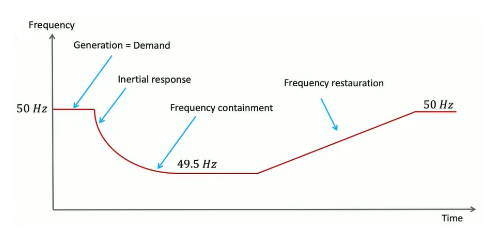1.3.2 Lecture Notes Ancillary Services Using Renewable Resources
Course subject(s)
1. Integration of Renewables Into the Electricity Grid

Image from freepik
This lecture discusses ancillary services using renewable energy resources. The main goal is to elaborate on several types of ancillary services in a renewable-rich power system and explain what role renewables have in this. The lecture will cover the following topics:
- Meaning of ancillary services
- Frequency support services
- Active power provisioning services
- Voltage support and reactive power provision services
- Other types of services
Meaning of ancillary services
Ancillary services are support services which are used to ensure reliable operation of the grid. Some of these services are provided by the grid operator and some are provided by large power companies. Some ancillary services are established through rules and regulations, other ancillary services are established through market and voluntary participation.
Frequency support services
The first set of services is related to frequency support. Whenever the power supply matches the power demand, the frequency will remain constant. If this is not the case, the frequency will increase or decrease, such that it will deviate from the nominal value. The control, maintain, and restoring of the frequency can be broken down into several segments of this ancillary service. This includes the inertial response reserves, the frequency containment reserves, and frequency restauration reserves. These segments are all called reserves since some power is reserved to be used when needed. These segments are shown in the figure below.

The restauration of the frequency can be performed by several segments of different sizes and duration. This can be provided by renewable energy resources if the renewable is operating below its maximum operating point or if it is enhanced with energy storage.
Inertial response is a new ancillary service because it was historically provided by large synchronous generators, which are typically found in fossil-fuel plants. However, in the renewable rich power system, inertia has to be provided by the renewable. Because most renewables (wind turbines and solar panels) do not have a synchronous generator, this has to be defined explicitly as a service to ensure a stable grid.
Active power provisioning services
The second set of services is related to active power provisioning, which are needed to ensure power balancing. Examples of an active power related ancillary service are:
- Ramping reserves, which are used to match the steep ramps in generation.
- Power smoothing, which ensures that the output power is sufficiently smoothen
- Grid congestion management, which is used to adjust equal amounts of active power of the opposite sign on both sides of the congested line.
Ancillary services closely related to active power services are energy services. These services supply a significant amount of power over a certain period of time (therefore the name energy services). Examples of these services are valley filling or peak shaving.
Voltage support and reactive power provisioning services
Voltage support is needed at transmission and at distribution level. By controlling reactive power injection, the desired shape of the voltage profile across the grid can be created. This is a localized service and must be supplied at the location in the grid where this is needed. Similar to frequency support services, renewable energy sources need to operate below their maximum power point or contain energy storage.
Other types of ancillary services
Besides the sets of services described above, there are also other types of ancillary services. Examples of other services are:
- Grid forming services refer to the ability to dictate the voltage of frequency in a grid.
- Black start services refer to the capability of starting up a power plant in a grid with no electricity.
- Fault current injection services are related to overcoming challenges with the protection system.
- Harmonic mitigation services refer to active harmonic filtering.
Conclusion
This lecture discussed different types of ancillary services. First the meaning of ancillary services was explained. After this, frequency support, active power, voltage support and reactive power provision, and other types of ancillary services were discussed.

Technology of Intelligent and Integrated Energy Systems by TU Delft OpenCourseWare is licensed under a Creative Commons Attribution-NonCommercial-ShareAlike 4.0 International License.
Based on a work at https://online-learning.tudelft.nl/courses/technology-of-intelligent-and-integrated-energy-systems/



